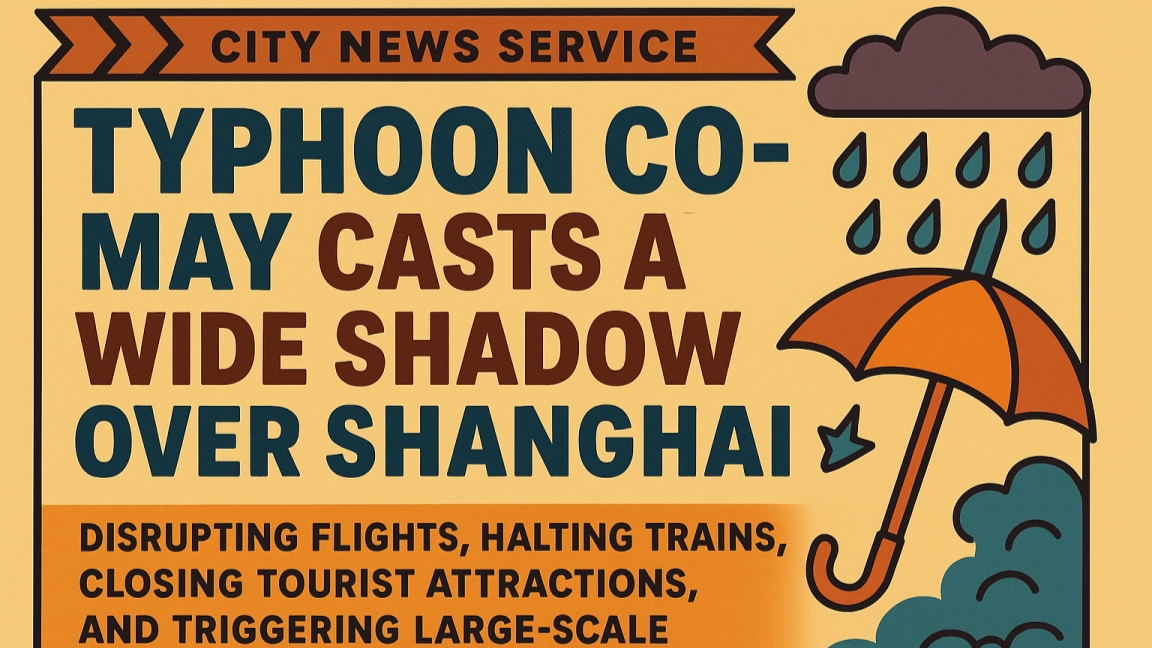
![[Quick News] Flights, trains, ferries hit as Shanghai braces for typhoon](https://obj.shine.cn/files/2025/07/29/e42e341b-1752-45b5-841c-5b932074bc35_0.png)
Typhoon Co-may has already cast an ominous shadow over Shanghai, disrupting flights, halting trains, closing tourist attractions and triggering large-scale emergency measures – all before it even makes landfall.
As the city braces for the full impact of the storm, which could arrive by Wednesday night, daily life has begun to slow, bend and adjust amid growing wind and rain.
Sightseeing boats on Suzhou Creek were suspended on Tuesday, and Shanghai's airports – Pudong and Hongqiao – reported numerous flight delays and cancellations, especially on routes to southern destinations like Guangzhou, Shenzhen, Haikou and Sanya.
In response, China Eastern Airlines announced flexible ticket change and refund policies, allowing one free change for affected passengers within three days of the original flight. Refunds for unused flight segments will also be processed without fees if requested within the ticket's validity period.
Train travel has been similarly affected. Shanghai's railway authorities canceled several services on the Hangzhou-Shenzhen line and others, including G7557 and G7657 on Tuesday, and G7658 and G7572 on Wednesday.
Other routes were shortened, such as trains that would normally run to Ningbo, Zhejiang Province, now terminating in Hangzhou, the provincial capital. More adjustments may follow depending on how Co-may's track evolves. Passengers holding tickets for canceled trains can apply for full refunds within 30 days through official railway platforms or stations.
Shanghai's landmarks haven't been spared, either. The Bihaijinsha scenic area and Fisherman's Wharf had closed their gates to visitors as of Tuesday.
![[Quick News] Flights, trains, ferries hit as Shanghai braces for typhoon](https://obj.shine.cn/files/2025/07/29/175b43e9-067a-4277-bdf9-55f3555b75ba_0.jpg)
Heavy clouds blanket the Bund as Typhoon Co-may approaches Shanghai.
Suburbs on alert
In suburban Fengxian District, where Co-may could make a second landfall after passing over coastal Zhejiang, teams have been inspecting everything from construction cranes and glass facades to vegetable greenhouses and signage for typhoon-related hazards.
With the risk of flooding high, authorities have prepared plans for emergency evacuations near rivers and are lowering water levels in canals in anticipation of heavy rainfall. Schools, businesses and transit operations stand ready to be suspended if conditions worsen.
In Chongming District, at the mouth of the Yangtze River, the preparations are even more intense. All ferry lines have been suspended, and 38 river sluice gates began pre-drainage operations on Monday afternoon.
Water levels have since fallen across Chongming, Changxing, and Hengsha islands, where emergency crews – over 10,000 people across 540 teams – are on standby to respond quickly to flooding or storm damage.
As the city holds its breath ahead of Typhoon Co-may's expected landfall, one thing is already clear: the storm's presence is being felt in full, long before the eye ever arrives.

